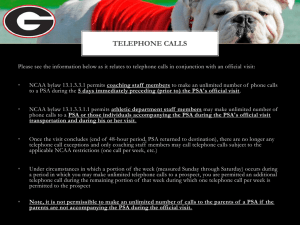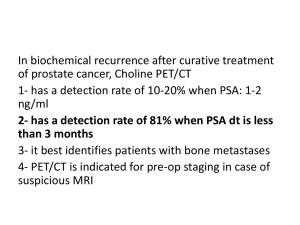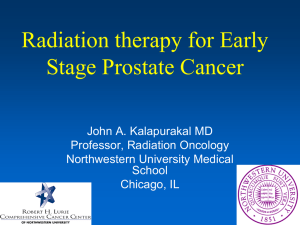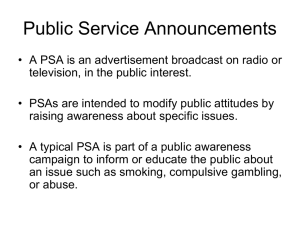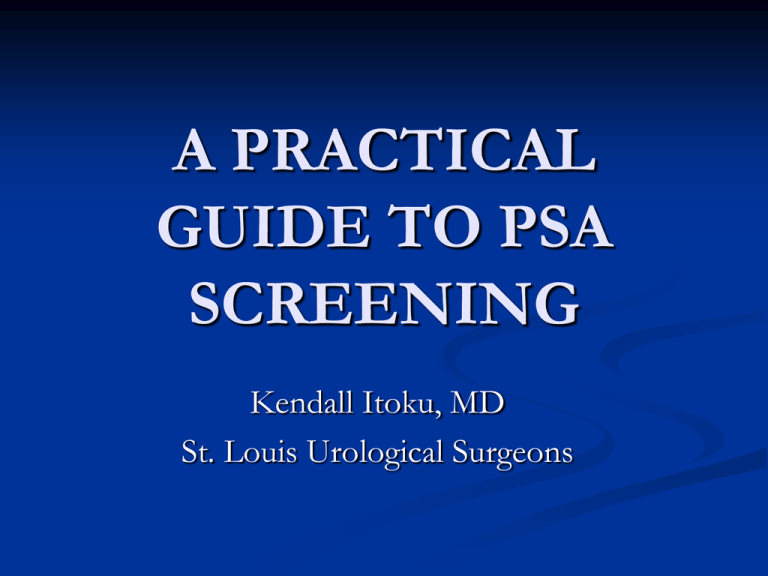
A PRACTICAL
GUIDE TO PSA
SCREENING
Kendall Itoku, MD
St. Louis Urological Surgeons
OBJECTIVES
GENERAL BACKGROUND INFORMATION
AND HISTORY OF PSA SCREENING FOR
PROSTATE CANCER
ADDRESS THE CONTROVERSY ON PSA
SCREENING: SHOULD SCREENING FOR
PROSTATE CANCER BE DONE?
PRACTICAL GUIDELINES FOR THE USE OF
PSA SCREENING FOR YOUR PATIENTS
PSA SCREENING SHOULD BE
DONE ANNUALLY FOR
EVERY MAN OVER 40
VS
PSA SCREENING IS THE
WORST PUBLIC HEALTH
DISASTER IN HISTORY AND
SHOULD NOT BE DONE
Prostate Specific Antigen (PSA)
Background Information
PSA is a glycoprotein produced by the epithelial cells
that line the ducts of the prostate gland.
Discovered in 1970 by Dr. Richard Ablin, University of
Arizona, Tucson.
Functions to help liquify semen.
Disruption of normal prostate architecture by
inflammation, infection, or cancer causes more PSA to
enter circulation.
DRE, ejaculation, vigorous sex does NOT significantly
alter PSA. Nor does dialysis.
Prostate Cancer Background Info
Prostate cancer is the most common noncutaneous
cancer in the US.
Prostate cancer is the 2nd leading cause of male cancer
mortality. (28,660 deaths 2008).
Lifetime risk of prostate cancer is estimated at 1/6.
(16%) Lifetime death risk 3.4%.
Prostate cancer risk is elevated in African American
men.
Prostate cancer risk is elevated in men whose father or
brother have prostate cancer.
Prostate Cancer Background Info
Since the 1990’s (when PSA screening came into
wide usage)
Prostate cancer deaths down 4.1% per year,
1996 to 2006.
Lower stage at time of diagnosis. (1988 19.2%
with locally advanced cancer. 1998 4.4% with
locally advanced cancer.)
PSA Testing is Currently Used for:
Evaluation of men at risk for prostate cancer.
Aid in early detection of prostate cancer.
Pretreatment staging and risk assessment for
men with prostate cancer.
Monitoring post treatment.
Guide management and treatment of men who
have a recurrence of prostate cancer.
American Urological Association
Recommendations
(Revised in 2009)
A baseline PSA should be done on all men
starting at age 40.
All men whose life expectancy is greater than 10
years should be screened.
Prior to PSA screening, risks and benefits
should be discussed.
No prescribed cutoff PSA level should trigger a
biopsy.
PSA Screening Recommendations
from other Organizations
American Cancer Society (ACS): Age 50 for average risk, 40 for
high risk
Centers for Disease Control and Prevention (CDC): Insufficient
evidence to determine whether benefits outweigh harms
US Preventive Services Task Force (USPSTF): Not in men 75 or
older, or those expected to live less than 10 years, otherwise
insufficient evidence to determine benefit.
American College of Preventive Medicine (ACPM):
Questionable in elderly men with other chronic illnesses and with
life expectancies fewer than 10 years.
Institute for Clinical Systems Improvement (ICSI): Not enough
evidence to clearly determine whether early detection and
treatment saves lives.
PROS
PSA Screening can help detect prostate cancer
early.
Prostate cancer is easier to treat and more likely
to be cured at an early stage.
PSA testing can be done with a simple, widely
available blood test.
CONS
Most prostate cancers are slow growing and
never metastasize.
Treatment for prostate cancer has risks and side
effects including incontinence, ED, chronic
bowel dysfunction.
PSA testing can be inaccurate with high false
positives and also false negatives.
PSA testing leads to invasive follow up tests.
Prostate Biopsy
Will “miss” the cancer 25% of the time.
1-4% Risk of significant bleeding or infection.
DRE
10% of patients with prostate cancer have a
normal PSA.
DRE can detect other diseases such as rectal
cancer, hemorrhoids, fissures.
Several controlled studies have indicated that
DRE combined with PSA increases accuracy of
screening.
However, fear of DRE may prevent a man from
undergoing screening.
Prostate, Lung, Colorectal, and
Ovarian Cancer Screening Trial
(PLCO)
76,693 men, randomized to get annual psa and
DRE for 6 years or “usual care”.
PSA level to trigger bx, 4.0
11.5 year follow up preliminary results show
22% more prostate cancer in study group vs
control group. But no decrease in prostate
cancer related mortality (92 deaths study group
vs 82 deaths control).
European Randomized Study of
Screening for Prostate Cancer
(ERSPC)
182,000 men randomized to PSA screening
every 4 years or control group.
PSA level to trigger bx, 3.0
At 9 years, 20% reduction in prostate cancer
deaths in the study group. (214 vs 326)
Prostate Cancer Prevention Trial
2950 healthy men, chemoprevention trial.
Randomized to finasteride or placebo.
7 year follow up, yearly prostate bx.
Prostate cancer in 6.6%, psa <0.5.
Prostate cancer in 26.9%, psa 3.1 to 4.0.
Showed reduction in prostate cancer by 24%
with finasteride.
Reminder:
PSA levels are elevated with prostatitis, UTI,
instrumentation.
Larger prostate gland will have a higher PSA.
PSA levels are lowered by 5 alpha reductase
inhibitors. (multiply by 2)
PSA levels are not significantly affected by sex
or DRE.
Tools to increase accuracy of PSA
screening.
Age specific normal ranges: <50-2.5, <60-3.5,
<70 4.5, <80-6.5
PSA velocity: 0.75 increase per year
Free/Total PSA ratio: 25% or greater is “good”
PSA density (PSA/gland volume): <.37ng/cc is
“good”. Requires TRUS.
Premises for My PSA Screening
Practical Guidelines
Prostate cancer is the most common cancer in men. (2010
estimates 217,730 new cases, 32,000 deaths)
Early stage, localized prostate cancer is “cured” over 90% of the
time.
Advanced prostate cancer has significant morbidity, including
bone pain and fractures, bleeding, anemia, ureteral obstruction.
PSA screening has and will continue to reduce the number of
deaths from prostate cancer.
Overdetection of prostate cancer is real, but justifiable,
temporary, and modified by judgment in screening.
Younger men are most likely to benefit from screening.
My Practical Guide to PSA Screening
Discussion of risks and benefits before screening.
Both DRE and PSA (unless pt refuses DRE).
First screening at age 40. If psa is less than 1, every 2-4 years till
age 50.
Yearly screening above age 50.
High risk men absolutely should be screened early and often.
(African American, Family Hx)
Age specific ranges for PSA threshold utilized. (<50-2.5, <603.5,<70-4.5, <80-6.5).
PSA velocity- 1 point in 1 year.
Discuss not screening in men over 80yo or those with life
expectancy less than 10 years. (Don’t screen if you won’t treat.)
My Guidelines for Screening after
Negative Biopsy
Repeat PSA and Free PSA in 6 months. If
stable, resume annual screening.
Repeat Biopsy based on PSA velocity. (If PSA
rises by 1 point in 1 year.)
If Free PSA is less than 7%, strongly consider
repeat biopsy, or closer f/u (q 6 months).
Atypia and PIN are difficult judgment calls.
Low threshold for repeat biopsy within 6
months.
Summary
No consensus
Plenty of evidence that screening is effective and
justifiable
Not screening is hard to defend.
Need reliable indicator to identify clinically
insignificant prostate cancer.
Use common sense and good clinical judgment.


